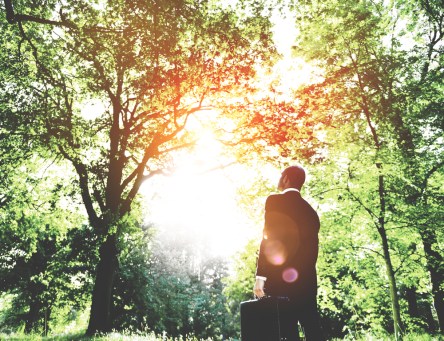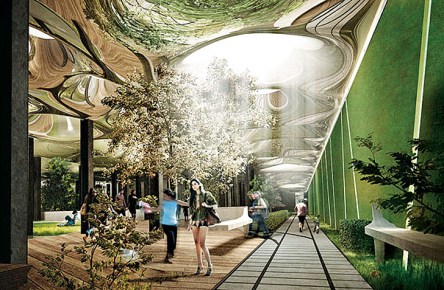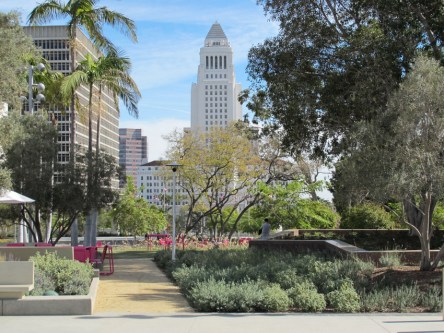July is national Parks and Recreation Month. Rather than simply celebrating the beauty of green spaces—which in itself is worthwhile—the National Recreation and Park Association challenges you “to explore the ‘undiscovered’ roles of local parks and recreation, like science, technology, engineering and math (STEM) programming; senior programs; innovative health and wellness opportunities; community celebrations; outdoor education; flood mitigation; maintenance; and more.” How parks play a role in such a diverse range of topics may not be immediately evident. We’ve put together a cheat sheet of five ways to enjoy parks from a new perspective. STEM With its broad base, the connections between STEM and parks offer endless opportunities. Adult groups may consider volunteering with your local parks. Volunteers can learn about trail construction and maintenance, sustaining wildlife, building footbridges, and tracking park activity cycles. Kids may start by identifying the state bird, state flower, and other wildlife and foliage. Have them observe the habitat in which it grows and how its presence affects other living things. (For example, fireflies enjoy living near ponds where they can readily feast on smaller insects. They are prey for birds that also live near the pond.) Of course, all work and no play makes for a dull day at the park! Be sure to work in playtime among your exploration of STEM. Senior Programs Seniors feel a stronger sense of inclusion in their community when they have exposure to green spaces. This can include walks, yoga or Tai Chi, volunteering in park events, and outdoor meditation sessions. While interacting with nature is ideal, it isn’t mandatory for seniors to receive health benefits. Studies show that simply sitting in nature or viewing it can improve a persons’ mental health and sense of well being. Wellness Opportunities Many parks host...
Health, Pets, & Parks...
Go Hand-in-Hand
Several recent studies reveal a strong correlation between pet and human health. By increasing the pet-friendliness of your site, you can boost park attendance and take proactive measures towards community wellness. A report by the American Veterinary Medical Association states that nearly 53 percent of dogs and 58 percent of cats are considered overweight or obese. Poor diets are one culprit. Processed pet foods are rich with grains, byproducts, preservatives, and even components of antifreeze. But perhaps the largest contributor to poor pet health is inactivity. Pets have adapted to the predominately indoor, sedentary lifestyles of their owners. Almost 70 percent of American adults are diagnosed as overweight or obese. Unhealthy eating habits and inconsistent physical activity are the leading factors. It may be possible to improve the health of pets and parents through the park system. The Journal of Physical Activity and Health reports that dog owners are more likely to achieve physical activity goals than people without dogs. Robert Taylor is a graduate student at Georgia Tech and a yoga teacher. Taylor has studied yoga for years and has always been mindful of his health. Yet once Laska—an adorable and playful field spaniel—came into his life nearly a year ago, his activity levels increased. There are several occasions where Taylor would skip cardiovascular activity if it weren’t for Laska. She motivates such healthy habits. “For her happiness and health, it is important for her to get moving some everyday at the very least. As a dog owner, I feel it is my responsibility to make sure her needs are met. She depends on me for so much that I feel it is unfair and wrong of me not to meet these needs. So, I am much more inclined to drag myself outside...
Safe Routes to Parks
Improve Health, Reduce Crime
Parks and Recreation Magazine recently published an article that offers insights into the benefits of green spaces. By promoting an active lifestyle and positively effecting human psychology, the Safe Routes to Parks program can transform the lives of the nation’s most vulnerable populations. Green spaces are a viable tool for improving public health and decreasing crime. Benefits of Green Spaces Research published in the Journal of Environmental Health Perspectives reveals that living in proximity to green space lowers the risk of all-cause, non-accidental mortality by 12 percent. Greenery reduces residents’ chances of dying from illnesses such as heart disease, diabetes, and cancer. Scott Brown at the University of Miami studied Medicare recipients in Miami-Dade County. Those who lived near green spaces experienced fewer chronic conditions: greenery reduced risk of diabetes by 14 percent, hypertension by 13 percent, and hyperlipidemia by 10 percent. The 2015 Urban Studies report finds that transforming vacant or gray spaces into green spaces reduces property crime and violent crime in the area. Marginalized neighborhoods—particularly urban, low-income communities—suffer in multiple ways from a shortage of green space. These communities are prone to crime, violence, poor air quality, and polluted waterways. Record-high obesity ratings, respiratory ailments, chronic disease and shorter life expectancy plague residents. Green spaces have the power to mitigate such ills in the communities that need them the most. Yet many high-risk neighborhoods lack green spaces. Those with parks face barriers to access. The National Recreation and Park Association’s Safe Routes to Parks Program aims to create parks and remove the barriers to attendance. Safe Routes to Parks Program The program first aims to create parks within a 10-minute walk of underserved communities. Studies reveal that residents within a 10-minute walk of a park have lower rates of obesity and...
National Park Week
Celebrate outside
Now through April 24, 2016 is National Park Week! The National Park Service (NPS) and National Park Foundation have designated this as a period of free park access, exciting events, and healthful activities. Don’t have time for a trip to the park? It’s more worthwhile than you think: time in nature has proven to improve mental health. Playing outside promotes mental and physical well-being while increasing productivity. A trip to the nearest National Park may be just what you need to refuel for the next big project on your calendar. So get outdoors and enjoy our National Parks! They are a source of endless beauty and wonder. Besides, you’ll be doing your mind and body a favor. Remember, National Park Week is more than just a celebration of nature. While that would be sufficient, the event is also a celebration of American heritage. Several National Historic Sites rest under the NPS umbrella. These are great alternatives if seasonal allergies or limited mobility make a romp outdoors sound more like a challenge than a celebration. Ready to explore? First, find your park or National Historic Site. (In honor of the upcoming presidential elections, it could be fun to visit destinations dedicated the former presidents.) All this week, guests can enjoy free admission to the NPS sites. Need a few National Park Week celebration ideas? Check out the scheduled events below: National Park Week includes the celebration of Earth Day, which falls on April 22. Do a quick search for Earth Day activities at a park near you. Once you’ve identified a nearby Earth Day volunteer event, organize a group of fellow coworkers to participate. Remember to bring a comfortable change of clothes if you’re heading out after work. It’s also a good idea to carpool—it’s...
Under Delancey Street...
New York's Lowline Project
A new era of metropolitan re-use and restoration is taking hold in cities around the world. On New York’s Lower East Side, two visionaries are taking the urban greenspace movement to the next level by putting it underground. With a planned debut in 2020, the LowLine project promises to create a calm, cultivated woodland atmosphere in an abandoned trolley terminal sprawled out beneath Delancey Street. Buried in New York’s Lower East Side lives a secret space and futuristic opportunity. In 1908, the Williamsburg Bridge Trolley Terminal debuted. The one-acre property located under Delancey Street primarily served trolley passengers traversing Manhattan’s submerged passageways. Though it’s been shuttered for more than 60 years, the original vaulted ceilings and cobblestone walkways still sit, patiently waiting for a new era of city residents to venture below. If James Ramsey and Daniel Barasch have their way, those Big Apple visitors will soon be enjoying a belowground wonderland, outfitted with hidden nooks, man-made stalagmites, trees and maybe even a hitchhiking frog or two all lit-up by the latest in solar-refraction technology. Christened the LowLine, this subterranean greenspace is part botanical garden, part laboratory, and part social experiment. For co-founders Ramsey and Barasch, the LowLine offers the chance to add much-needed greenery to one of the city’s most urban environments. A Shared Vision Manhattan’s Lower East Side represents a microcosm the borough’s transformation from humble, insular neighborhood into a jubilant melting pot of immigrants, boutique businesses, corporate high-rises and creative visionaries. When Ramsey learned of the Williamsburg trolley terminal in 2008, he was struck by its potential. He envisioned plants and trees thriving in a sort of “park” that would benefit the entire community. “It’s not every day that you find 60,000 square feet in New York, right?” Ramsey recently stated...
Green Space Reinvented...
The pluses of parks
In advocating for urban parks revitalization, the American Society of Landscape Architects (ASLA) is also fighting for a better quality of life for all Americans. Today, many communities are suffering from a lack of sustainable infrastructure, chronic stormwater management issues, lagging economies, poor health and limited recreational options. Neighborhood parks and other public green spaces have much to do with the creation of healthy environments for tourists and residents alike. Not only do parks provide a great place for socialization and recreational activities, but they are also credited with supporting economic development; improving public health; reconnecting children with nature; reducing crime; and providing safe, healthy alternatives for youth. In a recent statement, ASLA commended Congressman Albio Sires (NJ) for reintroducing the Community Parks Revitalization Act (CPRA), which would help communities rehabilitate existing and develop new outdoor spaces and recreational infrastructure. According to Nancy Somerville, Hon. ASLA, executive vice president and CEO of ASLA, the CPRA is an exceptional initiative that will contribute to enhancing the very essence of our communities. “Parks provide significant economic, social, and environmental benefits to everyone in the community. Parks are not just pretty places, but critical to the fabric of our daily lives” she noted. The bill is expected to stimulate neighborhood economic growth by leveraging limited public resources to generate community reinvestment; in other words, it will authorize grants for park and recreation agencies, which must be matched with local funds. Additionally, the CPRA includes a financing mechanism that would create a program for secured loans and loan guarantees for the development of parks and recreational facilities. The program, which was modeled after the popular Transportation Infrastructure Innovative Financing Act (TIFIA), would allow either large scale projects such as trail systems, or multiple communities to bundle multiple projects...






